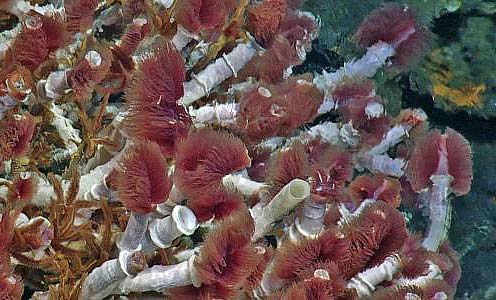40 Yrs Ago Oregon Coast Scientists Helped Discover Startling New Lifeforms
Published 02/26/2017 at 4:49 AM PDT - Updated 02/26/2017 at 4:59 AM PDT
By Oregon Coast Beach Connection staff

(Corvallis, Oregon) – Forty years ago, more than one OSU / Hatfield Marine Science Center oceanographer made a stunning discovery that changed science. This was truly a sea change: a discovery that involved a new form of life, and affected everything from theories on how life was started on Earth to how life on other worlds may be possible. It even influenced an episode of “The X-Files” TV show from the '90s. (Photo above courtesy Hatfield Marine Science Center: tubeworms living next to hydrothermal vents off the Oregon coast).
In 1977, OSU's Jack Corliss discovered a bizarre colony of sea creatures living deep in the ocean, in an area known as the Galapogos Rift. Living next to a hydrothermal vent, these clams, tube worms and other creatures had no visible source of light or food. But it turned out those sources were the vents themselves: the first known “extremophiles,” meaning creatures that live in extreme environments.
On March 2 and 3, Oregon State University will celebrate this revolutionary discovery with two presentations featuring Corliss himself, among other scientists from the Hatfield on the central Oregon coast. The two days of lectures and presentations happen in Corvallis called “OSU and Hydrothermal Vents: 40th Anniversary of the Discovery that Launched 1,000 Ships.”
On Thursday, March 2, there will be three short lectures from 3:30 to 5 p.m. in the Learning Innovation Center, Room 210. On Friday, March 3, events happen in Burt Hall Room 193 from 3:30 to 5 p.m. All events are free and open to the public.
Corliss will be traveling from Budapest, Hungary, where he now lives.
Among the presenters will be Robert Collier, a professor emeritus at OSU, who was a participant on that 1977 expedition. On Thursday, he and Corliss will discuss the history of the discovery and the new fields of study it spawned, which include astrobiology and new areas of chemistry.
Also appearing that day is Hatfield researcher Bill Chadwick, who will talk other hydrothermal discoveries in the Pacific Ocean, which will likely include those made off the Oregon coast. OSU and Hatfield oceanographer Andrew Thurber will describe how those unique lifeforms at hydrothermal vents can influence the climate.
Friday's events include Corliss and other members of the expedition holding an open forum on the discovery, which will be taped for historical purposes.
At the time of that discovery, the expedition dubbed the strange new hydrothermal vent community “The Garden of Eden.” Using a submersible and its mechanical arm, they collected samples of worms, mussels, anemones and clams, some of which are still housed today at the Smithsonian Institution.
Researchers first spotted the unusual creatures via an underwater sled equipped with a camera on February 15. They made their initial dive on February 17 in the submersible named Alvin, which has made numerous discoveries since then – including some on the sunken Titanic.
These extremophiles were found to be living of hydrogen sulfide – yes, the stuff that stinks like rotten eggs.
In the 1990s, the ninth episode of season 2 of The X-Files – called Firewalker – featured a killer in the form of an extremophile fungus that plagues an underground expedition. The episode was inspired by the finds of Corliss and crew.
For more on the Corvallis, Oregon events call 541-737-5208. More photos of hydrothermal vents below, courtesy the Hatfield Marine Science Center, as well as shots of the Hatfield.
More About Oregon Coast hotels, lodging.....
More About Oregon Coast Restaurants, Dining.....
Cannon Beach Lodging
Nehalem Bay Lodgings
Manzanita Hotels, Lodging
Three Capes Lodging
Pacific City Hotels, Lodging
Lincoln City Lodging
Depoe Bay Lodging
Newport Lodging
Waldport Lodging
Yachats Lodging
Oregon Coast Vacation Rentals
Oregon Coast Lodging Specials
LATEST Related Oregon Coast Articles
Likely just before dawn best hour but peak happens during daylight. Weather
Dark Sky Week is Prime Along Oregon Coast: Where and Where Not to Go
General guide to dark sky viewing from south to north coast. Astronomy
Sizable Price Drop, Deals in Lincoln City During Quiet of April on Central Or...
20 perc off at A1 Vacation Rentals across its roster, including Gleneden Beach. Lincoln City specials
Upcoming S. Oregon Coast Events Include Gem Show, History: Coos Bay, Bandon
May 6 talk at Coos History Museum, Mayfly Fest May 17, Bandon Rock / Gem Show June 7,8
Washington Coast Cleanup on April 19 - Coinciding with Oregon Coast's SOLVE E...
From the Puget Sound to Long Beach, alongside Oregon's cleanup. Washington coast events, Seaside events
Astoria's Riverwalk Gets New Lighting, More N. Oregon Coast Roadwork
Delays coming this summer, but the riverwalk has a new look. Seaside, Cannn Beach
April Gets Even Cheaper Midweek at Depoe Bay, Lincoln City: Oregon Coast Deals
Off-season rates plus more at Keystone Vacation Rentals. Depoe Bay lodging specials, Lincoln City hotel reviews, Newport hotel reviews
Washington Coast Begins Week of Clam Digs, April 12 Through 18
Long Beach, Twin Harbors, Mocrocks and Copalis at different times. Washington coast events
Back to Oregon Coast
Contact Advertise on BeachConnection.net
All Content, unless otherwise attributed, copyright BeachConnection.net Unauthorized use or publication is not permitted


















































